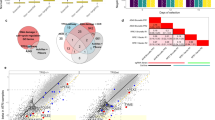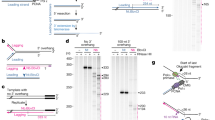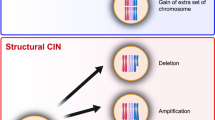Abstract
The mechanism of disease-associated trinucleotide repeat instability involves cis-acting factors (cis-elements) in the vicinity of the repeat, but the nature of these elements is unknown. One cis-element may be the location of the replication origin relative to the repeat. We have used an SV40 DNA replication system to investigate the effect of the location of replication initiation on (CTG)n•(CAG)n stability in primate cells. Depending on the distance between the SV40 replication origin and the repeat tract, templates with 79 repeats yield predominantly expansions or predominantly deletions or remain intact. All templates with 17 repeats are stable. Thus, cis-elements that affect the sites of Okazaki fragment initiation relative to the repeat are crucial determinants of instability. This model system recapitulates the bias for expansions observed in many of the diseases associated with trinucleotide repeats. Our results might explain the variable amounts of CTG/CAG instability that are observed in different chromosomal contexts.
This is a preview of subscription content, access via your institution
Access options
Subscribe to this journal
Receive 12 print issues and online access
$259.00 per year
only $21.58 per issue
Buy this article
- Purchase on SpringerLink
- Instant access to full article PDF
Prices may be subject to local taxes which are calculated during checkout






Similar content being viewed by others
Accession codes
References
Cummings, C.J & Zoghbi, H.Y. Fourteen and counting: unraveling trinucleotide repeat diseases. Hum. Mol. Genet. 9, 909–916 (2000).
La Spada, A.R. Trinucleotide repeat instability: genetic features and molecular mechanisms. Brain Pathol. 7, 943–963 (1997).
Martorell, L., Monckton, D.G., Sanchez, A., Lopez De Munain, A. & Baiget, M. Frequency and stability of the myotonic dystrophy type 1 premutation. Neurology 56, 328–335 (2001).
Richards, R.I. & Sutherland, G.R. Heritable unstable DNA sequences. Nature Genet. 1, 7–9 (1992).
Richards, R.I. & Sutherland, G.R. Dynamic mutations: a new class of mutations causing human disease. Cell 70, 709–712 (1992).
Wong, L.J., Ashizawa, T., Monckton, D.G., Caskey, C.T. & Richards, C.S. Somatic heterogeneity of the CTG repeat in myotonic dystrophy is age and size dependent. Am. J. Hum. Genet. 56, 114–122 (1995).
Martorell, L. et al. Progression of somatic CTG repeat length heterogeneity in the blood cells of myotonic dystrophy patients. Hum. Mol. Genet. 7, 307–312 (1998).
Wohrle, D. et al. Heterogeneity of DM kinase repeat expansion in different fetal tissues and further expansion during cell proliferation in vitro: evidence for a casual involvement of methyl-directed DNA mismatch repair in triplet repeat stability. Hum. Mol. Genet. 4, 1147–1153 (1995).
Ashizawa, T. et al. Instability of the expanded (CTG)n repeats in the myotonin protein kinase gene in cultured lymphoblastoid cell lines from patients with myotonic dystrophy. Genomics 36, 47–53 (1996).
Ashizawa, T. et al. Characteristics of intergenerational contractions of the CTG repeat in myotonic dystrophy. Am. J. Hum. Genet. 54, 414–423 (1994).
Richards, R.I. et al. Dynamic mutation loci: allele distributions in different populations. Ann. Hum. Genet. 60, 391–400 (1996).
Imbert, G., Kretz, C., Johnson, K. & Mandel, J.L. Origin of the expansion mutation in myotonic dystrophy. Nature Genet. 4, 72–76 (1993).
Neville, C.E., Mahadevan, M.S., Barcelo, J.M. & Korneluk, R.G. High resolution genetic analysis suggests one ancestral predisposing haplotype for the origin of the myotonic dystrophy mutation. Hum. Mol. Genet. 3, 45–51 (1994).
Biancalana, V. et al. Moderate instability of the trinucleotide repeat in spino bulbar muscular atrophy. Hum. Mol. Genet. 1, 255–258 (1992).
Spiegel, R., La Spada, A.R., Kress, W., Fischbeck, K.H. & Schmid, W. Somatic stability of the expanded CAG trinucleotide repeat in X-linked spinal and bulbar muscular atrophy. Hum. Mutat. 8, 32–37 (1996).
Gourdon, G. et al. Moderate intergenerational and somatic instability of a 55-CTG repeat in transgenic mice. Nature Genet. 15, 190–192 (1997).
Monckton, D.G., Coolbaugh, M.I., Ashizawa, K.T., Siciliano, M.J. & Caskey, C.T. Hypermutable myotonic dystrophy CTG repeats in transgenic mice. Nature Genet. 15, 193–196 (1997).
Brock, G.J., Anderson, N.H. & Monckton, D.G. Cis-acting modifiers of expanded CAG/CTG triplet repeat expandability: associations with flanking GC content and proximity to CpG islands. Hum. Mol. Genet. 8, 1061–1067 (1999).
Kang, S., Jaworski, A., Ohshima, K. & Wells, R.D. Expansion and deletion of CTG repeats from human disease genes are determined by the direction of replication in E. coli. Nature Genet. 10, 213–218 (1995).
Samadashwily, G.M., Raca, G. & Mirkin, S.M. Trinucleotide repeats affect DNA replication in vivo. Nature Genet. 17, 298–304 (1997).
Freudenreich, C.H., Stavenhagen, J.B. & Zakian, V.A. Stability of a CTG/CAG trinucleotide repeat in yeast is dependent on its orientation in the genome. Mol. Cell. Biol. 17, 2090–2098 (1997).
Freudenreich, C.H., Kantrow, S.M. & Zakian, V.A. Expansion and length-dependent fragility of CTG repeats in yeast. Science 279, 853–856 (1998).
Miret, J.J., Pessoa-Brandao, L. & Lahue, R.S. Orientation-dependent and sequence-specific expansions of CTG/CAG trinucleotide repeats in Saccharomyces cerevisiae. Proc. Natl Acad. Sci. USA 95, 12438–12443 (1998).
Schweitzer, J.K. & Livingston, D.M. Expansions of CAG repeat tracts are frequent in a yeast mutant defective in Okazaki fragment maturation. Hum. Mol. Genet. 7, 69–74 (1998).
Anderson, S. & DePamphilis, M.L. Metabolism of Okazaki fragments during simian virus 40 DNA replication. J. Biol. Chem. 254, 11495–11504 (1979).
Burhans, W.C., Vassilev, L.T., Caddle, M.S., Heintz, N.H. & DePamphilis, M.L. Identification of an origin of bidirectional DNA replication in mammalian chromosomes. Cell 62, 955–965 (1990).
Tseng, B.Y., Erickson, J.M. & Goulian, M. Initiator RNA of nascent DNA from animal cells. J. Mol. Biol. 129, 531–545 (1979).
DePamphilis, M.L. & Wassarman, P.M. Replication of eukaryotic chromosomes: a close-up of the replication fork. Annu. Rev. Biochem. 49, 627–666 (1980).
Waga, S. & Stillman, B. The DNA replication fork in eukaryotic cells. Annu. Rev. Biochem. 67, 721–751 (1998).
Hay, R.T. & DePamphilis, M.L. Initiation of SV40 DNA replication in vivo: location and structure of 5′ ends of DNA synthesized in the ori region. Cell 28, 767–779 (1982).
Nethanel, T., Reisfeld, S., Dinter-Gottlieb, G. & Kaufmann, G., Okazaki piece of simian virus 40 may be synthesized by ligation of shorter precursor chains. J. Virol. 62, 2867–2873 (1988).
Gordenin, D.A., Kunkel, T.A. & Resnick, M.A. Repeat expansion—all in a flap? Nature Genet. 16, 116–118 (1997).
Spiro, C. et al. Inhibition of FEN-1 processing by DNA secondary structure at trinucleotide repeats. Mol. Cell 4, 1079–1085 (1999).
Henricksen, L.A., Tom, S., Liu, Y. & Bambara, R.A. Inhibition of flap endonuclease 1 by flap secondary structure and relevance to repeat sequence expansion. J. Biol. Chem. 275, 16420–16427 (2000).
Roberts, J.D. & Kunkel, T.A. Fidelity of a human cell DNA replication complex. Proc. Natl Acad. Sci. USA 85, 7064–7068 (1988).
Pearson, C.E. & Sinden, R.R. Alternative structures in duplex DNA formed within the trinucleotide repeats of the myotonic dystrophy and fragile X loci. Biochemistry 35, 5041–5053 (1996).
Pearson, C.E., Ewel, A., Acharya, S., Fishel, R.A. & Sinden, R.R. Human MSH2 binds to trinucleotide repeat DNA structures associated with neurodegenerative diseases. Hum. Mol. Genet. 6, 1117–1123 (1997).
Pearson, C.E., Wang, Y.H., Griffith, J.D. & Sinden, R.R. Structural analysis of slipped-strand DNA (S-DNA) formed in (CTG)n.(CAG)n repeats from the myotonic dystro locus. Nucleic Acids Res. 26, 816–823 (1998).
Gluzman, Y. SV40-transformed simian cells support the replication of early SV40 mutants. Cell 23, 175–182 (1981).
Hirt, B. Selective extraction of polyoma DNA from infected mouse cell cultures. J. Mol. Biol. 26, 365–369 (1967).
Vassilev, L. & Johnson, E.M. Evaluation of autonomous plasmid replication in transfected mammalian cells. Nucleic Acids Res. 16, 7742 (1988).
Gacy, A.M., Goellner, G., Juranic, N., Macura, S. & McMurray, C.T. Trinucleotide repeats that expand in human disease form hairpin structures in vitro. Cell 81, 533–540 (1995).
Constantinou, A. et al. Werner's syndrome protein (WRN) migrates Holliday junctions and co-localizes with RPA upon replication arrest. EMBO Rep. 1, 80–84 (2000).
Seigneur, M., Bidnenko, V., Ehrlich, S.D. & Michel, B. RuvAB acts at arrested replication forks. Cell 95, 419–430 (1998).
Postow, L., Crisona, N.J., Peter, B.J., Hardy, C.D. & Cozzarelli, N.R. Topological challenges to DNA replication: conformations at the fork. Proc. Natl Acad. Sci. USA 98, 8219–8226 (2001).
Manley, K., Shirley, T.L., Flaherty, L. & Messer, A. Msh2 deficiency prevents in vivo somatic instability of the CAG repeat in Huntington disease transgenic mice. Nature Genet. 23, 471–473 (1999).
Moore, H., Greenwell, P.W., Liu, C.P., Arnheim, N. & Petes, T.D. Triplet repeats form secondary structures that escape DNA repair in yeast. Proc. Natl Acad. Sci. USA 96, 1504–1509 (1999).
Richard, G.F., Goellner, G.M., McMurray, C.T. & Haber, J.E. Recombination-induced CAG trinucleotide repeat expansions in yeast involve the MRE11-RAD50-XRS2 complex. EMBO J. 19, 2381–2390 (2000).
Hay, R.T., Hendrickson, E.A. & DePamphilis, M.L. Sequence specificity for the initiation of RNA-primed simian virus 40 DNA synthesis in vivo. J. Mol. Biol. 175, 131–157 (1984).
Griffith, J.D. & Christiansen, G. Electron microscope visualization of chromatin and other DNA-protein complexes. Annu. Rev. Biophys. Bioeng. 7, 19–35 (1978).
Acknowledgements
We thank our colleagues at The Hospital for Sick Children for comments and support, and A. Paterson for statistical analysis. This work was supported by grants from the Muscular Dystrophy Association USA and the Canadian Institutes of Health Research (CIHR) to C.E.P. and from the NIH and the March of Dimes to Y.-H.W. J.D.C. is supported by Natural Sciences and Engineering Research Council of Canada. C.E.P. is a CIHR Scholar, a Canadian Genetic Disease Network Scholar and a Premier's Research Excellence Award scholar. Y.-H.W. is a Basil O'Connor March of Dimes Fellow.
Author information
Authors and Affiliations
Corresponding author
Ethics declarations
Competing interests
The authors declare no competing financial interests.
Rights and permissions
About this article
Cite this article
Cleary, J., Nichol, K., Wang, YH. et al. Evidence of cis-acting factors in replication-mediated trinucleotide repeat instability in primate cells. Nat Genet 31, 37–46 (2002). https://doi.org/10.1038/ng870
Received:
Accepted:
Published:
Issue date:
DOI: https://doi.org/10.1038/ng870
This article is cited by
-
Dynamic alternative DNA structures in biology and disease
Nature Reviews Genetics (2023)
-
Group II intron and repeat-rich red algal mitochondrial genomes demonstrate the dynamic recent history of autocatalytic RNAs
BMC Biology (2022)
-
A slipped-CAG DNA-binding small molecule induces trinucleotide-repeat contractions in vivo
Nature Genetics (2020)
-
Contraction of fully expanded FMR1 alleles to the normal range: predisposing haplotype or rare events?
Journal of Human Genetics (2017)
-
Contracting CAG/CTG repeats using the CRISPR-Cas9 nickase
Nature Communications (2016)



